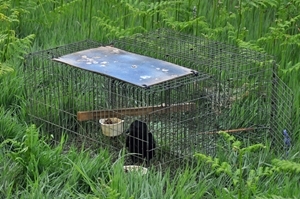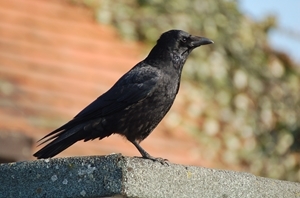Why call-birds work
 A call-bird is a previously caught magpie or crow, which is kept alive in the special decoy compartment of the trap. Uncaught territory holders think a single call-bird is an intruder and will try to drive it away. They are very aggressive, and if the trap is left in peace, few are so shy that they will not get caught. In a scientifically conducted experiment by the Game & Wildlife Conservation Trust in 1989, traps with call-birds were 15 times more efficient at catching crows, and 10 times more efficient for magpies.
A call-bird is a previously caught magpie or crow, which is kept alive in the special decoy compartment of the trap. Uncaught territory holders think a single call-bird is an intruder and will try to drive it away. They are very aggressive, and if the trap is left in peace, few are so shy that they will not get caught. In a scientifically conducted experiment by the Game & Wildlife Conservation Trust in 1989, traps with call-birds were 15 times more efficient at catching crows, and 10 times more efficient for magpies.
How to handle call-birds
Both crows and magpies can give a fairly painful nip and their claws are also sharp, but neither are really capable of breaking the skin of an adult human. However, it is wise to use a gardening glove when handling them for health reasons. Concentrate on handling the bird securely, but gently.
As you put your hand into the trap, a magpie will flutter round the roof, whereas a crow will try to cram itself into a bottom corner. Pin the bird gently against the floor, roof or side of the trap, sliding your first and second fingers round its neck so that they meet at the fingertips. The bird can’t bite you now, and so long as you don’t let it wriggle its head between these two fingers, it can’t get away from you. Your palm will be over the bird’s back, and you can use your thumb and fourth and fifth fingers to pin the wings against the body as you pick it up.
Both species grip with their feet: use your free hand to gently prise them open again. When taking call-birds out of the decoy compartment of a Larsen trap, you will find you have to bring them tail first through the access hole.
Birds can be transported humanely to another trap in a dark rigid box with proper ventilation. Remember it is in your interests to look after the bird. A sack is not good enough and may well be illegal.
Taking care of your call-birds
Look after your call-birds well. They will work best for you when in good health, because they move about more in the trap and catch the attention of territory holders. They also call vocally but won’t if they are miserable.
The General Licences impose a legal obligation to physically visit each call-bird at least once a day at intervals of not more than 24 hours to renew food and water. If call-birds are seen by territory holders to be actively feeding, they will arouse special jealousy. (Apart from this, you are bound by animal welfare laws, and are furthermore responsible for the public reputation of game and wildlife management.) These birds drink a lot of water and the General Licences stipulate that it should be free from chemical additives and changed regularly to ensure that it is clean. Earthenware hamster bowls make good non-tipping receptacles, but a better option is to use a nipple drinker bottle as used for pet rabbits. This helps to prevent the water becoming dirty and reduces evaporation loss in hot weather. Please also note if you are trapping in cold early spring weather, you must ensure that the water remains unfrozen in daylight hours. Note that under the current licences operators are required to avoid using traps in extreme weather conditions, whether hot or cold.
Various kinds of food are suitable for feeding the decoy, but we have found ‘sausages’ of brawn-type dog food, fed with bread, to be very convenient. Another choice is complete diet dog food (soaked in water) or even lamb pellets. If you feed your call-bird with carrion, make sure it is cut up, or at least cut open, as magpies can have great difficulty in getting into an intact carcass. Please also be aware that carrion can be attractive to non-target species and may look gruesome to members of the general public. We therefore suggest that the use of complete dog food is probably the best policy. The use of fallen farmstock as bait or food in traps is illegal under EU and UK Animal By-Products Regulations.
Remember to remove leftovers and clean the cages properly. Moving the trap a few yards on to fresh ground each day prevents a build-up of droppings and old food in the decoy compartment. Rotten food is not a suitable diet and certainly does not convey a best practice image.
The licences allowing use of Larsens specify that you must provide adequate food, water at all times, appropriate shelter, and a perch.
Magpies and crows need a perch particularly for roosting at night, and the licence requires you to provide the call-bird with a suitable perch “which will not cause discomfort to the bird’s feet”. Make sure the perch cannot accidentally fall down. There must be adequate shelter from hot sun, rain or wind. When early season trapping in upland areas it is worth considering the use of a side cowling to keep the wind off the call-bird and fresh captives.
The General Licences do not permit you to keep decoys in Larsen traps that are not set or not in use. Larsen traps are too small for long-term housing – you must use a suitable aviary, large enough to allow the birds to stretch their wings freely, and it must have food, water, shelter and ideally more than one perch. A 3m x 1.5m A-frame shaped pen of the type often used for gamebirds has been found to work well. Remember that birds kept in an aviary should be checked every day.
Do not wing clip your birds
A well-publicised court case addressed the issue of whether a wing-clipped decoy (i.e. feather clipped) was ‘maimed’ and therefore illegal to use under the Provisions of the Wildlife and Countryside Act 1981. Although the case concluded that wing clipping was not a maim, we are against this practice not least because it could be a legal grey area under the Animal Welfare Act 2006.
It does not enhance the welfare of the decoy and does nothing to improve the effectiveness of the trap. It also means that if someone liberates your decoy there is a high risk that it will suffer a slow death by starvation. The liberator is unlikely to realise that the decoy is wing clipped until it is out of the trap. Interestingly, a recent study conducted by the GWCT looking at magpie predation on songbirds showed that leg-ringed magpies were often re-caught many times over, so released decoys that have been well cared for may well be recoverable.
Which species to use as a call-bird

In the wild, crows are dominant to magpies and drive them from their territories. For this reason, crows can be caught to magpie decoys, but the reverse is rarely true.
The General Licences allowing Larsens specify that they may only be used with carrion crows, magpies, jays, rooks, jackdaws and ring-necked or monk parakeets as decoys. Use of the parakeets as decoys is advisable only where they are present in the wild, for example, in the south east of England.
After a while, call-birds become quite tame and phlegmatic. Some people believe that recently caught territory-holders make the best call-birds, as they are more restless and aggressive, but we do not have evidence to support this. In fact, we feel that keeping the same caller is easier and less disruptive to the birds. A bird like this could also be a good option for transferring to an aviary for the non-trapping period to help ensure a quick start to the next season.
Where to get your first call-bird
Please do not contact us to ask where you can get a call-bird. Ask your gamekeeper friends, or catch your own. Larsen traps work quite effectively with bait alone. (You may even care to keep a couple of tame birds from year to year to start you off each spring. They are really fascinating creatures, and if you take an interest, you will learn a lot). Please also remember that it is illegal to trade in live magpies and crows.
Download Larsen Trap Guide >